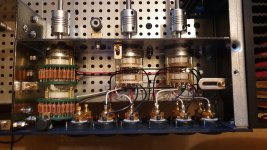Folks, when there's a rod between the front panel and the potentiometer, what the heck is it called? Is there a place to purchase these or do people manufacture them DIY?
like this:

like this:
Extension shaft.
I go to Home Depot or Lowes, get a 1/4" aluminum rod and cut it to size.
A coupler and a front panel bushing and.... done.
I like to keep the input selector switch near and in a shielded box next to the input jacks.
Insures a quiet amp.
Been done like this for decades.
I go to Home Depot or Lowes, get a 1/4" aluminum rod and cut it to size.
A coupler and a front panel bushing and.... done.
I like to keep the input selector switch near and in a shielded box next to the input jacks.
Insures a quiet amp.
Been done like this for decades.
In my experience the kits for sale as potentiometer or attenuator extension shafts with a mounting bracket and a rod are rubbish quality. Just buy a length of rod and make your own mounts. Highly recomend you use a flexible coupler too, they are commonly available as shaft couplers for 3D printers.
Attachments
Be careful what you buy.
The Al rod you can buy at HD will say 0.25 inches, but several reviews reported the diameters of their purchases were off by as much as +.012, making it unsuitable for applications without sufficient tolerances.
Kind regards,
Drew
The Al rod you can buy at HD will say 0.25 inches, but several reviews reported the diameters of their purchases were off by as much as +.012, making it unsuitable for applications without sufficient tolerances.
Kind regards,
Drew
Can't buy a $1.09 potentiometer and bust the body off?The bushings are a problem for me.
Excellent idea! 💡Most of us have at least one worn pot in the parts bin.Can't buy a $1.09 potentiometer and bust the body off?
I recall once embedding a spare 1/4" (6.35 mm) ID sealed ball bearing for the purpose (the front panel was wooden). Used an old Johnson-style universal coupling for the potentiometer connection. Overkill perhaps, but they're what I happened to have on hand at the time. No side play and silky smooth.
Nice links WntrMute2, thanks!
PRR, I’m not visualizing a pot with the body busted off for the bushing in the chassis front panel? I think I’m misunderstanding something, hehe.
PRR, I’m not visualizing a pot with the body busted off for the bushing in the chassis front panel? I think I’m misunderstanding something, hehe.
Most cheap pots (such as the one linked) have a die cast threaded part that's easily separated from the rest of the assembly. You could just as easily "salvage" one from an old junked radio or stereo. Any bumps or protrusions can be filed away if you find them aesthetically unpleasing. Easy peasy.
https://www.tubesandmore.com/products/potentiometer-linear-16mm-marshall-style
https://www.tubesandmore.com/products/potentiometer-linear-16mm-marshall-style
Ahh Ha! Got it now.
I do have a bag of old pots removed from dead gear. Perfect!
Thanks for the tips 👍
I do have a bag of old pots removed from dead gear. Perfect!
Thanks for the tips 👍
With the parts linked in this short thread a high quality extension shaft combo can be had, much better quality than the "kit" offerings from eBay, Ali, Audiophonics, etc... I use aluminum 1" x 2" L-angle to make a bracket to hold the potentiometer/selector switch.
GD-Parts sells them... https://www.goodcomponent.com/products/knobspotentiometers/potentiometers/1450.html
Or to paraphrase: "I bought stuff at the cheapest outlet available and now I'm shocked to find that it's not machined to precision tolerances". Um. Yeah... About those TPS reports...Be careful what you buy.
The Al rod you can buy at HD will say 0.25 inches, but several reviews reported the diameters of their purchases were off by as much as +.012, making it unsuitable for applications without sufficient tolerances.
Aluminum rod is extruded and it's very common for extruded materials to be slightly oversized. The idea being that you can machine them to the specified size. If you need a rod with tight tolerances on the diameter, buy drill rod. McMaster-Carr carries it.
The rods are commonly marketed as shaft extensions. The gizmos used to connect the shaft extension to the potentiometer are shaft couplings. McMaster-Carr has the couplings too.
The idea behind the coupling is to take up any slight discrepancy in position/angle between the pot shaft and the extension shaft. If you use a coupling you get a smooth feel to the knob. Without the coupling you'll likely find that the control binds in one spot.
Tom
(SHW) SFTBUSH.25 $3.95 eachBrass panel bushing
(SHW) SFTBUSH.409 $8.90 each
Now go to the pots pages. A 50-cent pot:
Bend back the 4 tabs on front and the back falls off.
I forgot this next step. There is a groove with a ring in it keeping the shaft in. You have to work the ring loose with a nut-pick or dental-pick. Now the shaft slides out, releasing the resistor wafer. Depending on brand, the bushing may be mounted in the sheetmetal different ways. As you say, most of us have a box of dubious pots to play with.
If you don't have lock ring pliers you can usually nudge the ring off with a small screwdriver. I don't even want to know what a nut-pick is... 🙂I forgot this next step. There is a groove with a ring in it keeping the shaft in. You have to work the ring loose with a nut-pick or dental-pick. Now the shaft slides out, releasing the resistor wafer.
I like the idea of reusing the bushing from a potentiometer. That's excellent.
Tom
- Home
- Design & Build
- Construction Tips
- Vocabulary: volume control rod?

